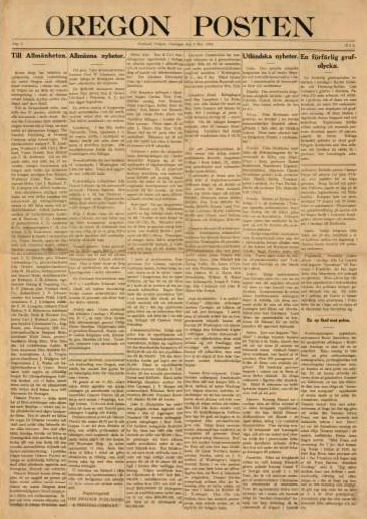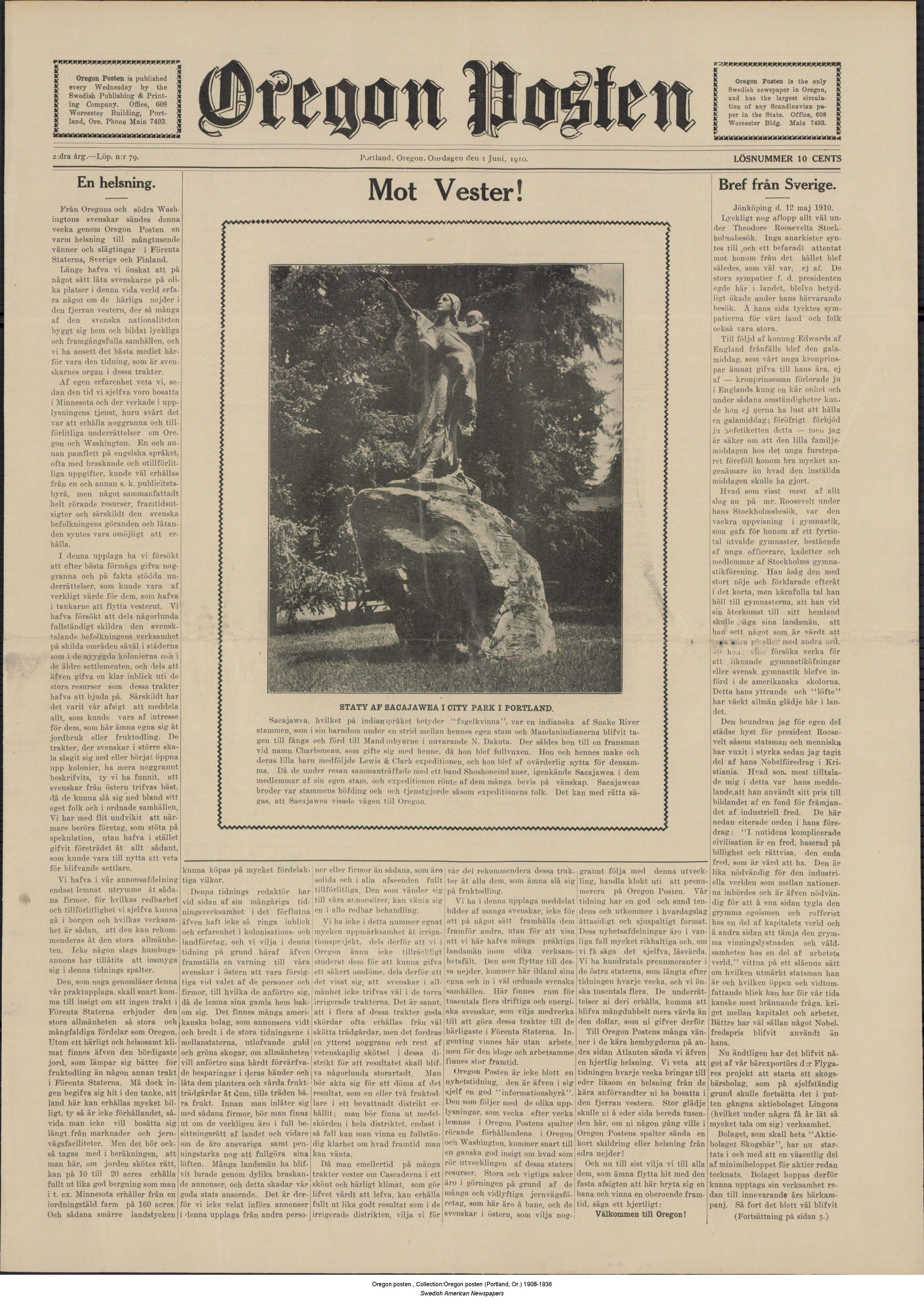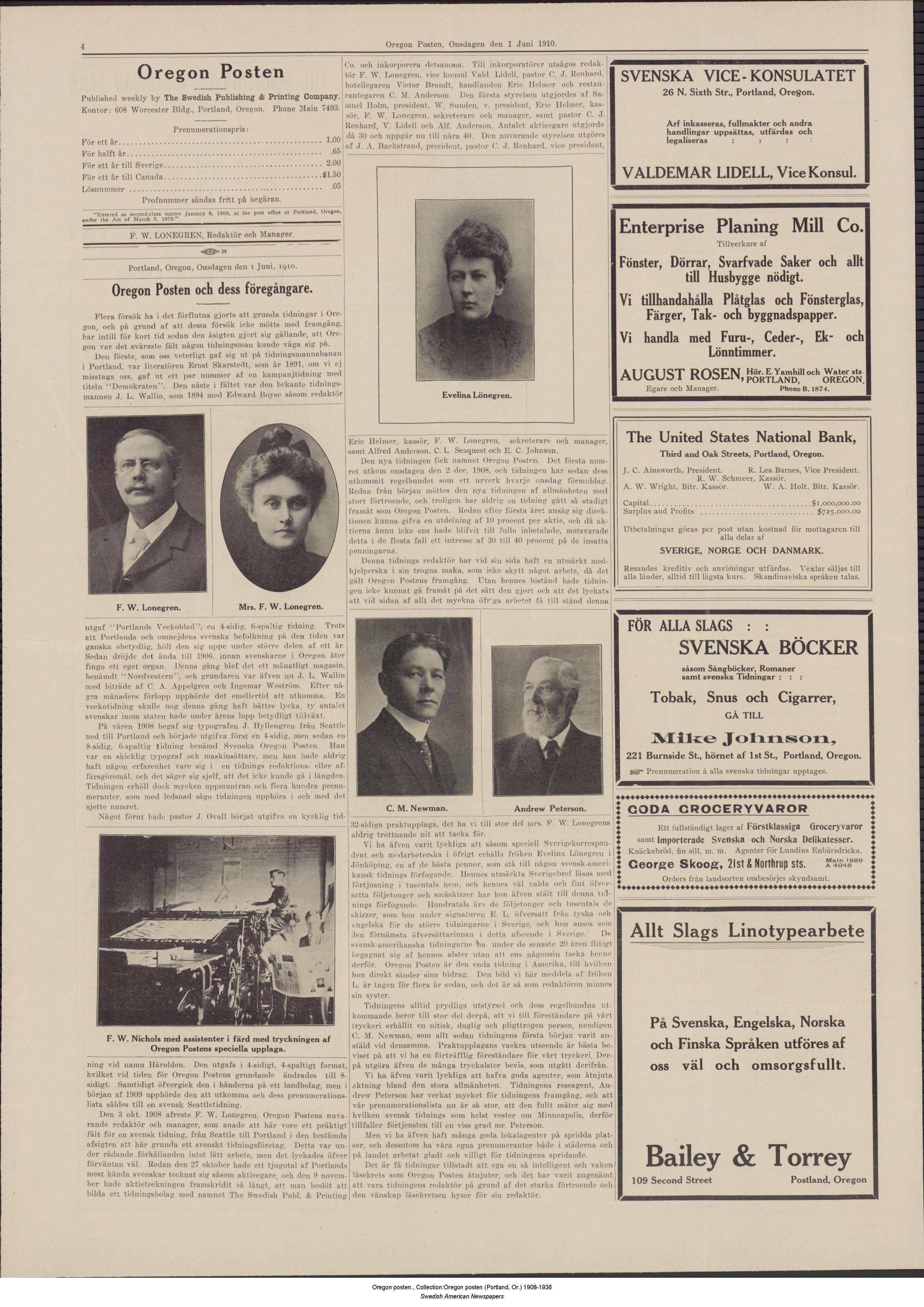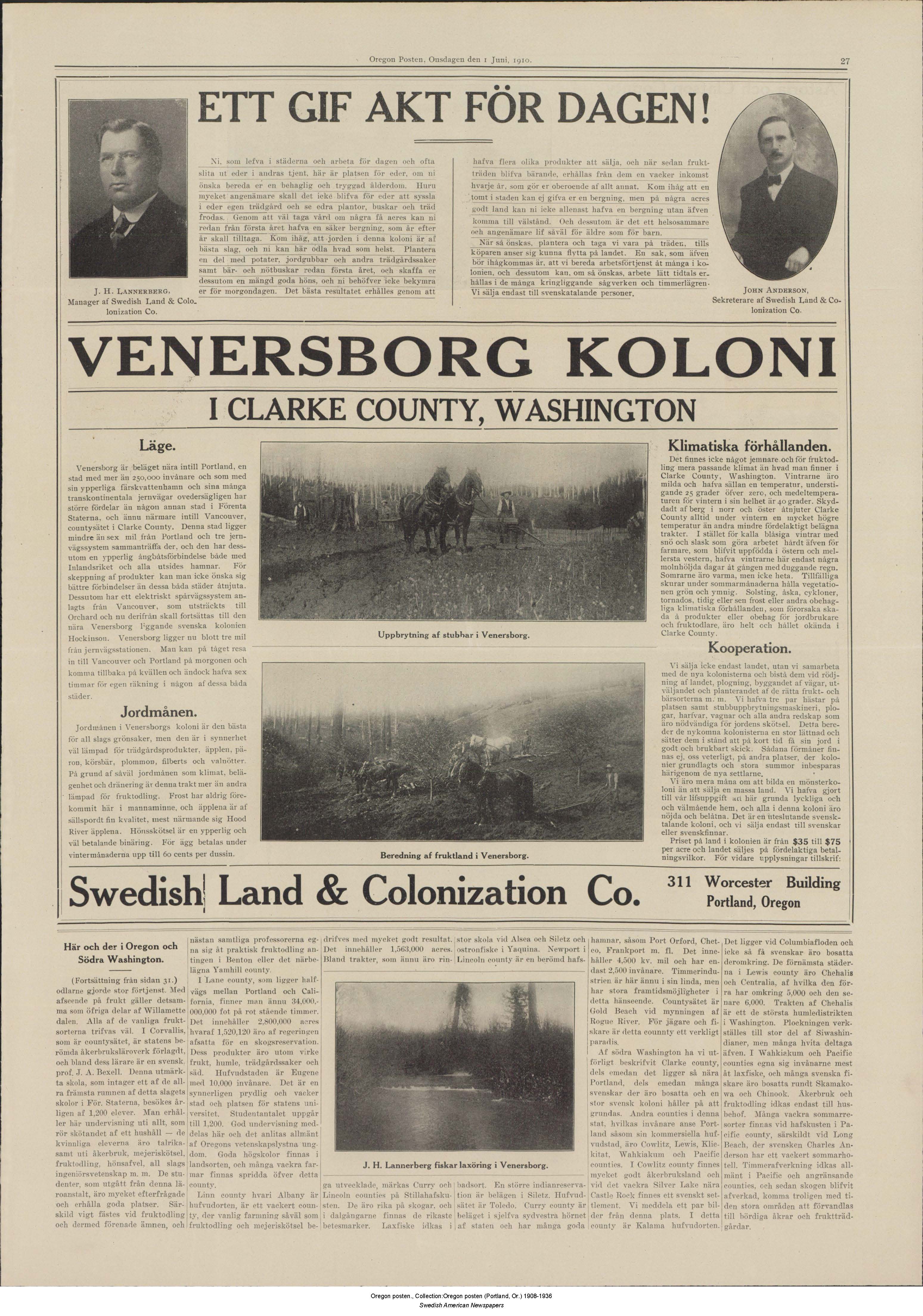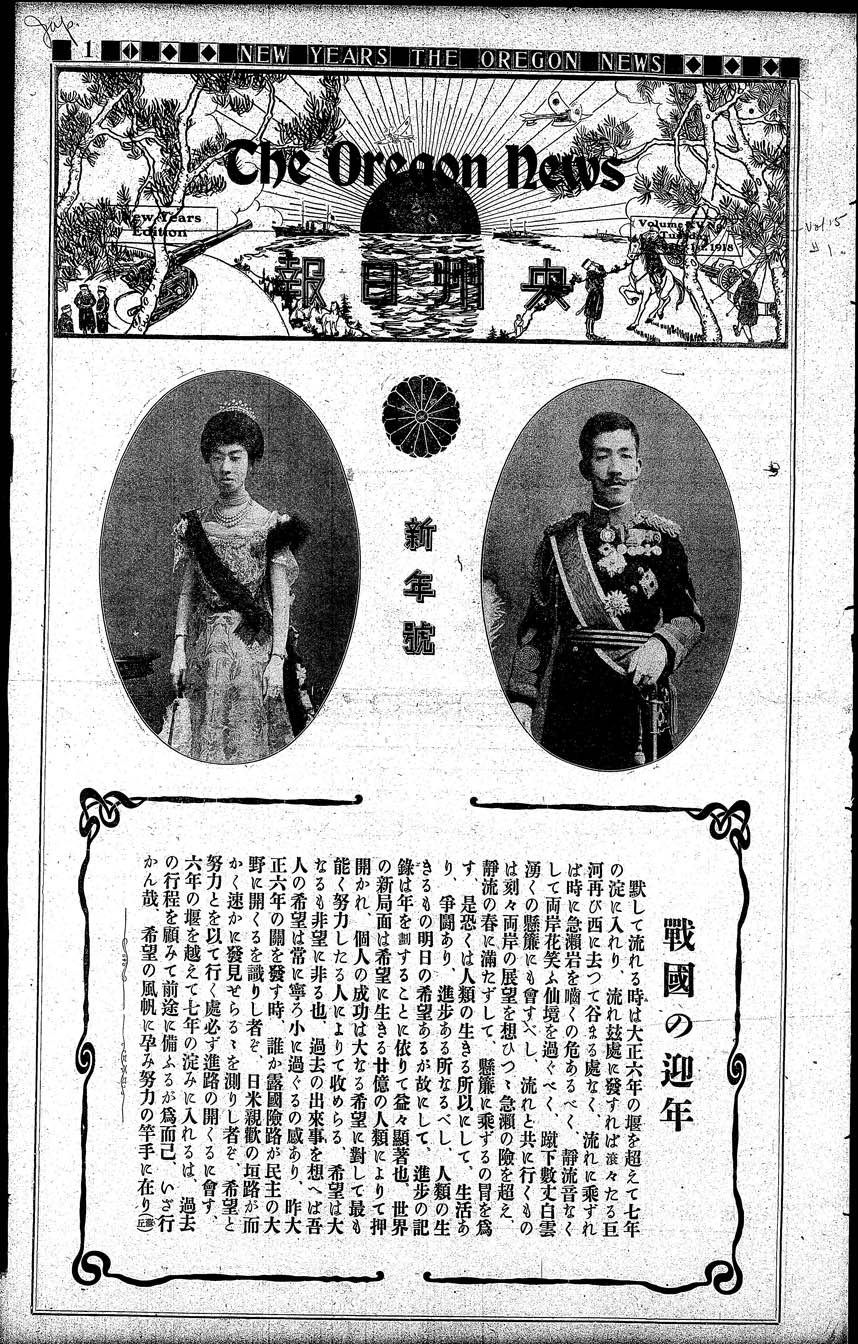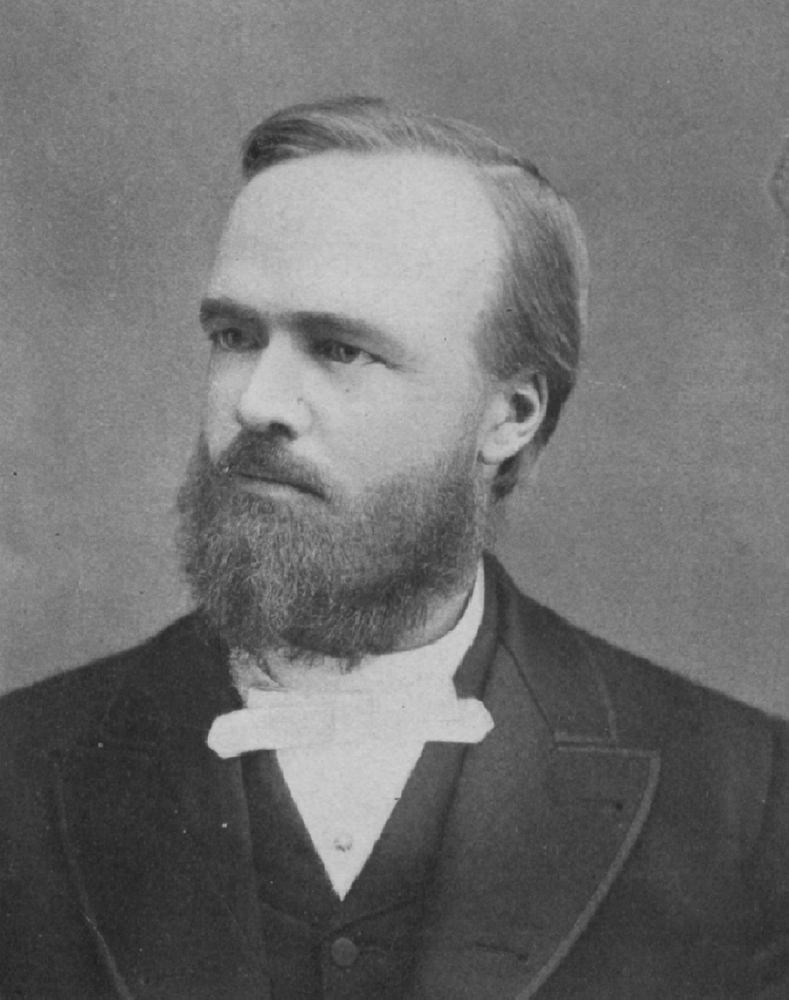The first issue of the weekly Oregon Posten (Oregon Post), the state’s largest Swedish newspaper, was published on December 2, 1908, with Fredrik Wilhelm Lönegren as editor. The paper, whose format would stay essentially the same for twenty-seven years, published information about Swedish culture and heritage, promoted Oregon’s Swedish institutions and businesses, and encouraged Swedes to immigrate to the state.
Lönegren, born in Sweden in 1860, was twenty-nine years old when he moved to Portland on October 3, 1908, to start Oregon Posten. Thousands of Swedish-born people lived in Oregon at the time—more than ten thousand in 1910—making it one of the largest immigrant groups in the state. Six Swedish papers and journals had been published in Oregon before Oregon Posten, but all of them had failed. Nevertheless, within a month Lönegren had collected enough Swedish stockholders to start the Swedish Publishing & Printing Company.
American newspapers kept Swedish readers informed about their new state, while Oregon Posten kept them connected with their home country and Swedish communities in the United States. The newspaper also provided a forum for issues concerning Swedish Americans, and promoted Swedish organizations such as the Swedish Lutheran church in Oregon and southern Washington, the Swedish Society Linnea and the Vasa Order, and Swedish choral societies.
Advertisements in Oregon Posten confirmed that Swedes worked in almost every part of Portland’s business sector. There were Swedish-owned hotels and restaurants, grocery stores, bookstores, shoe stores, a pharmacy, and a hat shop. There was also a Scandinavian American Bank in 1910, which had several Swedish stockholders and managers. Swedish doctors, dentists, and lawyers also advertised in the paper. Almost all of the ads were in Swedish and were designed to appeal to Swedish readers. A Meier & Frank Department Store ad, for example, provided contact information for a Swedish man who worked in the men’s department.
In 1912, Oregon Posten had 3,250 subscribers in Oregon and in other states, Canada, and Sweden. By 1915, the paper had 2,800 subscribers, many who subscribed for their relatives in Sweden. The number of subscribers, however, did not represent the number of people who actually read the paper. It was common for a person to buy a subscription and then share it with family and neighbors. In October 1910, Gust Dunberg of Wisconsin wrote that the special edition of Oregon Posten he had received was completely worn out because it had been passed from person to person.
In 1909, an annual subscription to Oregon Posten cost a dollar. Subscribers in Canada paid a dollar fifty, and those in Sweden paid two dollars. When printing costs increased during World War I, the paper had to increase subscription prices slightly. One reader who had lived in Oregon wrote to say how much he enjoyed reading about people he had known in the state, and another who used the pseudonym “göingebonde” (Göinge farmer) wrote that he appreciated Oregon Posten more than he did Swedish newspapers.
Oregon Posten often published articles encouraging people to move to Oregon. On June 1, 1910, for example, the paper published a thirty-two page special issue, “The Grand Edition,” that provided information and advertisements about Oregon churches, organizations, and land opportunities. Editor Lönegren attempted to mitigate the high land prices in Oregon. “If the land is handled right,” he wrote on June 1, 1910, “10-20 acres is enough and gives as good a result as 160 acres in Minnesota.” Some people traveled to Oregon after they read the special issue, and at least one reader had already bought some land in the state. “We can give hundreds of examples of Swedish families which have by reading the newspaper decided to settle down in or around Swedish colonies in Oregon and contributed to a greater state,” Lönegren wrote on November 21, 1917.
Through Oregon Posten, Lönegren encouraged readers to teach children Swedish and to embrace their home country’s culture. The paper repeatedly told readers that they did not have to excuse themselves for being Swedish and that their citizenship was as worthy as someone’s whose relatives had arrived on the Mayflower.
In 1932, after twenty-three years as editor of Oregon Posten, the seventy-two-year-old Lönegren retired. In his farewell letter, he wrote: “It has been a joy to see how the love for the native place and the Swedish language have sustained among most people even throughout a long stay in this our adoptive country.” Svenska Journalen (Swedish Journal), a Seattle newspaper, began publishing Oregon Posten, and a new editor, H. Youngstrom, kept an office in Portland to gather news; editor Nils Brown was added to the paper in 1932.
In 1910, 348 Swedish newspapers and journals were published in the United States; that number had declined to 40 by 1931 and to 19 by 1942. In 1940, there were only 8,498 Swedish-born people in Oregon. As the first generation of Swedes died and as American Swedes married outside their communities and embraced more American traditions, the Swedish language was spoken less and the need for a Swedish newspaper disappeared.
The last issue of Oregon Posten was published on January 23, 1936. Svenska Journalen bought the newspaper, and it merged with Puget Sound Posten into a new paper called Svenska Posten (Swedish Post). Svenska Posten, which served the region for forty years, published a column from Portland and printed obituaries.
-
![Swedish American Newspapers project: http://www.mnhs.org/newspapers/swedishamerican/oregon-posten]()
First issue of Oregon Posten, December 2, 1908.
Swedish American Newspapers project: http://www.mnhs.org/newspapers/swedishamerican/oregon-posten Courtesy Minnesota Historical Society
-
![]()
Fredrik Wilhelm Lönegren.
Courtesy Minnesota Historical Society
-
![Swedish American Newspapers project: http://www.mnhs.org/newspapers/swedishamerican/oregon-posten]()
Oregon Posten, front page of the Praktupplagan issue, June 1, 1910.
Swedish American Newspapers project: http://www.mnhs.org/newspapers/swedishamerican/oregon-posten Courtesy Minnesota Historical Society
-
![Swedish American Newspapers project: http://www.mnhs.org/newspapers/swedishamerican/oregon-posten]()
Oregon Posten, masthead page, June 1, 1910.
Swedish American Newspapers project: http://www.mnhs.org/newspapers/swedishamerican/oregon-posten Courtesy Minnesota Historical Society
-
![]()
Oregon Posten, ads in the Praktupplagan issue, June 1, 1910.
Courtesy Minnesota Historical Society, Swedish American Newspapers project -
![Swedish American Newspapers project: http://www.mnhs.org/newspapers/swedishamerican/oregon-posten]()
Oregon Posten, ads in the Praktupplagan issue, June 1, 1910.
Swedish American Newspapers project: http://www.mnhs.org/newspapers/swedishamerican/oregon-posten Courtesy Minnesota Historical Society
Documents
Related Entries
-
Ernst Skarstedt (1857-1929)
Ernst Teofil Skarstedt was the first author and newspaper publisher to …
-
![Fredrik Wilhelm Lönegren (1860-1937)]()
Fredrik Wilhelm Lönegren (1860-1937)
Fredrik Wilhelm Lönegren moved to Portland on October 3, 1908, to start…
-
![Oshu Nippo]()
Oshu Nippo
For early Japanese immigrants to Oregon, a Japanese-language newspaper …
-
Samuel Magnus Hill (1851-1921)
Samuel Magnus Hill came to Oregon in 1915 as minister of the Swedish Ca…
-
![Swedish Americans in Oregon]()
Swedish Americans in Oregon
The Swedes were at one time one of the largest immigrant groups in Oreg…
-
Vi Gale (1917 -2007)
Oregon poet and publisher Vi Gale was born Viola Håkansson in rural Nor…
Related Historical Records
Map This on the Oregon History WayFinder
The Oregon History Wayfinder is an interactive map that identifies significant places, people, and events in Oregon history.
Further Reading
Lönegren, F.W. Oregon Posten. Swedish Pub. & Print. Co.: Portland, Ore., December 2, 1908- January 23, 1936.
Capps, Finis H. From Isolationism to Involvement; the Swedish Immigrant Press in America, 1914-1945. Chicago: Swedish Pioneer Historical Society, 1966.
Skarstedt, Ernst. Washington och Dess Svenska Befolkning. Seattle, Washington: Washington Printing Co., 1908.
Skarstedt, Ernst. Oregon och dess Svenska Befolkning. Seattle, WA: Washington Printing Co.,1911.
Smith, William Carlson. The Swedes of Oregon. Philadelphia, PA: American Swedish Historical Museum Year Book, 1946.

